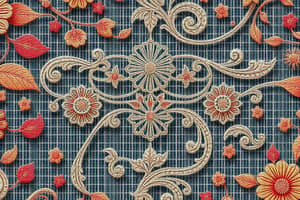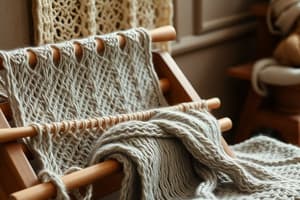Podcast
Questions and Answers
What is knitting?
What is knitting?
- A process of sewing pre-made pieces of fabric together to create a finished garment.
- A process of using a single needle to create a finished garment or fabric.
- A process of using a loom to create a finished garment or fabric.
- A process of using two or more needles to pull and loop yarn into a series of interconnected loops to create a finished garment or fabric. (correct)
Which country invented the stocking frame or the mechanical knitting machine?
Which country invented the stocking frame or the mechanical knitting machine?
- Egypt
- Spain
- England (correct)
- Scotland
Which country had the earliest known knitted items in Europe?
Which country had the earliest known knitted items in Europe?
- Spain (correct)
- Italy
- Egypt
- France
What was the significance of knitting during World War I?
What was the significance of knitting during World War I?
When did the popularity of knitting show a sharp decline in the Western world?
When did the popularity of knitting show a sharp decline in the Western world?
What led to a resurgence in knitting in the early 21st century?
What led to a resurgence in knitting in the early 21st century?
What is yarn bombing?
What is yarn bombing?
Which celebrities have helped to popularize knitting?
Which celebrities have helped to popularize knitting?
What is Ravelry?
What is Ravelry?
Flashcards
What is knitting?
What is knitting?
Knitting involves using two or more needles to pull and loop yarn into a series of interconnected loops, creating a finished garment or fabric.
Why was knitting popular early on?
Why was knitting popular early on?
Knitting doesn't require large equipment like looms, making it suitable for nomadic and non-agricultural communities.
When did knitting first appear?
When did knitting first appear?
The oldest known knitted objects are socks from Egypt, dating back to the 11th century.
When was the knitting machine invented?
When was the knitting machine invented?
Signup and view all the flashcards
Why did knitting become popular during WWI?
Why did knitting become popular during WWI?
Signup and view all the flashcards
When did knitting experience a surge in popularity in the 20th century?
When did knitting experience a surge in popularity in the 20th century?
Signup and view all the flashcards
How did the internet contribute to knitting's return?
How did the internet contribute to knitting's return?
Signup and view all the flashcards
How have celebrities influenced knitting?
How have celebrities influenced knitting?
Signup and view all the flashcards
What is yarn bombing?
What is yarn bombing?
Signup and view all the flashcards
Study Notes
A Brief History of Knitting
-
Knitting is a process of using two or more needles to pull and loop yarn into a series of interconnected loops to create a finished garment or fabric.
-
Knitting does not require a loom or other large equipment, making it a valuable technique for nomadic and non-agrarian peoples.
-
The oldest knitted artifacts are socks from Egypt, dating from the 11th century.
-
The earliest known knitted items in Europe were made by Muslim knitters employed by Spanish Christian royal families.
-
Knitting was an important occupation among those living on the Scottish Isles during the 17th and 18th centuries.
-
The stocking frame or the mechanical knitting machine was invented in 1589 by William Lee, an English clergyman.
-
During World War I, men, women, and children knitted large quantities of clothing and accessories to help the war effort on the Allied side.
-
The 1920s saw a vast increase in the popularity of knitwear in much of the western world.
-
The prominence of knitwear in fashion of the 1920s continued, but reflected the changes of fashion.
-
Hand-knitting reached its peak during World War II following the encouragement to knit for the war efforts.
-
The popularity of knitting showed a sharp decline during the 1980s in the Western world.
-
Technological advances such as computerised knitting machines saw new designs and approaches to knitting.The Resurgence of Knitting
-
Knitting was originally developed as a practical skill for making clothes, but gradually became a popular hobby in the 20th century.
-
The 1960s and 70s saw an increase in knitting's popularity, with many people learning the skill in school.
-
In the 1980s, the focus shifted to knitting as an art form, with more attention paid to design possibilities.
-
The decline of suppliers and wool shops led to a reduction in knitting's popularity, but it still had a loyal following.
-
The growth of the internet and the ability to share patterns and advice led to a resurgence in knitting in the early 21st century.
-
Natural fibers from animals and plants have become more widely available, and novelty yarns and quick-knitting patterns have also contributed to knitting's popularity.
-
Celebrities such as Julia Roberts and Cameron Diaz have helped to popularize knitting.
-
Men have also returned to the art of knitting, and there are now books aimed at a male readership.
-
The internet has allowed knitters to connect and share interests, and knitting podcasts and blogs have emerged.
-
Traditional designs and techniques are finding a wider audience.
-
Yarn bombing, a type of graffiti, has also become popular.
-
The 2006 Knitting Olympics and the founding of Ravelry, an online community for knitters and crocheters, are further signs of knitting's popularity.
Studying That Suits You
Use AI to generate personalized quizzes and flashcards to suit your learning preferences.




